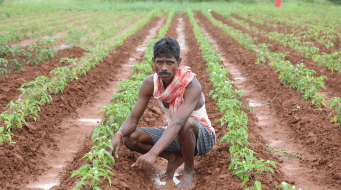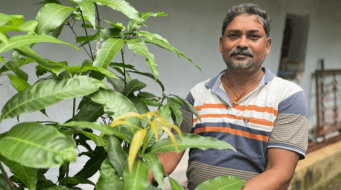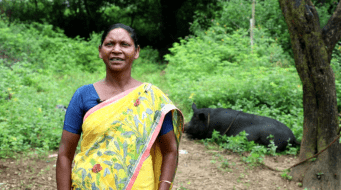– Saumyadeb Dasgupta
If you have watched ‘Into the Wild’ and liked it, I apologize at the onset. There is very little evidence to suggest that human beings function well in nature alone in the absence of basic structures. I swear, I don’t have any issue with Chris McCandless embracing nature and then dying, almost poetically, through the process. I am a bit iffy about the way humans have this first-world view on nature, like it’s some sort of primal reset button which heals your soul and spirit from the attrition of humanity. Let’s be honest, we hardly understand how to deal with nature with enough examples throughout the history of mankind to fill entire bookshelves. Believe it or not, the only groups of people who can be said to understand the forces of nature in its unabated form are the farmers, having dealt with it for centuries. Today, we shift the focus on them.
You see, agriculture is a tricky business. It is heavily dependent on the geography and climate of a particular region. Farmers inculcate generations of experience that has been passed on to them in every step on there way – from sowing till harvesting of crops and maintaining the soil productivity through the process. Also, there is a cost-benefit analysis carried out all through. Now here’s the problem, over the past decade, changing climate scenarios have brought the effectiveness of these traditional practices into question. Unseasonal and variable rainfalls, strong winds, hailstorms, heatwaves, cold waves have started baffling farmers as they try to restore the delicate balance between man and nature. To this effect, Watershed Organisation Trust (WOTR) has initiated an intervention where SMS (Short Message Service) advisories are sent to farmers about impending weather conditions from locally collected meteorological data with the idea that early-warnings can mitigate the adverse impacts of unpredictable weather changes. Sounds simple? Well, the socio-economic dynamics involved in this are far more complex if we delve a little deeper.
Everyone intends to earn the maximum profit out of their land. If the crops are not ready to be harvested, 2-3 days of warning is meaningless because harvesting at such a stage will inevitably lead to low market prices defeating the most important objective. It makes more sense to keep them in the field and hope that a portion of it survives the adverse weather event and reaches maturity. Now, for those whose crops are ready to be harvested, a few factors need to be considered. First and foremost, different crops require different approaches to harvest hence, different manpower and proportionally, time. Even if you get a 2-day heads-up, you’d need manpower. If you have a big family to help you out, fantastic. Otherwise, good luck finding labour when everybody around you is looking for the same. Eventually you wind up shelling out extra money because of high demand which eat into the income from the crops. As a result, farmers end up making complex cost-benefit analyses to obtain the best outcome.
In Jalna district of Maharashtra, wheat is one of the major crops taken during Rabbi season. Things get even more intriguing once you consider that while harvesting wheat, the plants are first cut into bundles of 20 or 30 and the bundles kept are evenly distributed all along the field, to be fed later to the threshing machine. Now, according to the farmers, if you have standing crops and you receive a bad weather alert, it’s better to keep them standing rather than cutting them into bundles because that reduces chances of crop damage. Those who can afford the combined harvesting machines would be much better off because they would probably secure their grains in a day or so. But those who can afford the use of such machines are already financially better off. Other crops like gram and sorghum are usually collected in a single place during harvesting which makes them easier to be saved by using polythene covers as a preventive measure. Farmers in Jalna tend to keep their cotton in the fields till the month of March to squeeze out the last bit of profit from the soil. Naturally, it becomes of utmost important to quickly harvest the last of the cotton bolls when a bad weather warning is issued through the weather stations.
The weather advisories also influence whether the crops would be watered in the upcoming days. Wheat is usually watered by flooding the fields through channels adjacent to the crop rows. A bad weather event would usually be accompanied by strong winds which could potentially cause the water from the channels to go directly to the roots. This is pretty bad for the wheat because the roots have a tendency to decay and loosen up if exposed to standing water. Hence, farmers would refrain from watering the fields in the face of bad weather advisories. Similarly, insecticide and pesticide spraying is also dependent on the weather advisories. Farmers would withhold such activities prior to rainfall advisories because otherwise these expensive chemicals are washed away, incurring further expenses to the farmers. Also an advisory such as one forecasting hailstorm usually prompts the farmers to take care of their livestock without much ado. They are usually herded inside the sheds to prevent them from getting hurt because apart from the added expense of taking care of an injured or sick animal, they would otherwise also lose out on earnings from reduced milk productivity of the livestock.
Hence, the general consensus about the weather advisories is positive, with most farmers agreeing that they are accurate to almost 90% in terms of locale specific information. They definitely see a value in this considering the changing climate patterns have started baffling the common sense of the farmers which they acquired through generations of experience. However, the farmers who are illiterate, who amount to a sizable portion of the population, are still alienated from its direct benefits. What becomes important here is that farmers engage in discussions whenever potentially important advisories pop up. This dissemination of information through inclusive discussions then makes up for the limitation of the system although its dependence on the cohesiveness of the village society cannot be ignored.
The SMS advisory ticks two very important boxes in terms of effectiveness. First, the notification of a message causes the recipient to immediately look at his/her phone and get the weather alert advisory, making it truly, as real-time as it could possibly get. Using Google as an alternative is a bit tedious because you would have to actually go into the app and search for weather alerts which no one does while they’re out, working in the field. Secondly, as accurate as the weather applications like AccuWeather are, they still don’t provide cluster or village level advisories. More importantly, it creates a rare occasion where the integration of technology with agriculture makes sense and is accepted by the community in a positive manner. Maybe, the weather advisories will help tip the balance in the favor of the farmers as we enter the uncertain times of climate change.





